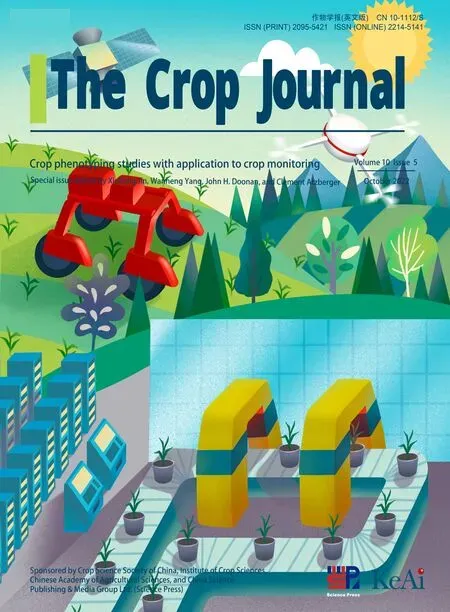Quantifying the effects of stripe rust disease on wheat canopy spectrum based on eliminating non-physiological stresses
Xi Jing ,Kiqi Du ,Wein Dun,b ,Qin Zou ,Tingting Zho,b ,Bingyu Li ,Qixing Ye,Lieshen Yn,b
a College of Geomatics,Xi’an University of Science and Technology,Xi’an 710054,Shaanxi,China
b Key Laboratory of Digital Earth Science,Aerospace Information Research Institute,Chinese Academy of Sciences,Beijing 100094,China
Keywords:Difference-in-differences Wheat stripe rust Severity level Non-physiological stress Independent effects
ABSTRACT The wheat canopy reflectance spectrum is affected by many internal and external factors such as diseases and growth stage.Separating the effects of disease stress on the crop from the observed mixed signals is crucial for increasing the precision of remote sensing monitoring of wheat stripe rust.The canopy spectrum of winter wheat infected by stripe rust was processed with the difference-in-differences(DID)algorithm used in econometrics.The monitoring accuracies of wheat stripe rust before and after processing with the DID algorithm were compared in the presence of various external factors,disease severity,and several simulated satellite sensors.The correlation between the normalized difference vegetation index processed by the DID algorithm (NDVI-DID) and the disease severity level (SL) increased in comparison with the NDVI before processing.The increase in precision in the natural disease area in the field in the presence of large differences in growth stage,growth,planting,and management of the crop was greater than that in the controlled experiment.For low disease levels(SL<20%),the R2 of the regression of NDVI-DID on SL was 38.8% higher than that of the NDVI and the root mean square error (RMSE) was reduced by 11.1%.The increase in precision was greater than that for the severe level (SL >40%).According to the measured hyperspectral data,the spectral reflectance of three satellite sensor levels was simulated.The wide-band NDVI was calculated.Compared with the wide-band NDVI and vegetation indexes (VIS) before DID processing,there were increases in the correlation between SL and the various types of VIS-DID,as well as in the correlation between SL and NDVI-DID.It is feasible to apply the DID algorithm to multispectral satellite data and diverse types of VIS for monitoring wheat stripe rust.Our results improve the quantification of independent effects of stripe rust infection on canopy reflectance spectrum,increase the precision of remote sensing monitoring of wheat stripe rust,and provide a reference for remote sensing monitoring of other crop diseases.
1.Introduction
Changes in leaf pigment and water content,photosynthetic physiological status,and canopy geometry occur when a crop is infested with a pathogen[1].Variation in crop reflectance spectra,corresponding to the magnitude of the disease’s effect on crop physiology,biochemistry,and canopy structure [2],provides a direct basis for remote sensing detection of crop diseases[3].However,the reflectance spectrum information detected by the sensor is also affected by the combined influence of external factors such as growth stage and canopy geometry.Reducing or eliminating interference from external factors,quantifying the effects of disease stress on the canopy spectrum,and increasing the precision of remote sensing monitoring of crop diseases is a challenging problem.
Changes in the reflectance of the leaf surface in the visible-near infrared band caused by crop diseases reflect the condition of the physical and biochemical components of the vegetation [3].They provides rich information about the physiological stresses on the crop[4].Disease-sensitive bands observed in the reflectance spectrum are combined in a linear or nonlinear manner to form vegetation indexes,which not only have a clear physical meaning,but also capture weak spectral signals,magnify spectral information sensitive to disease,reduce interference to the spectrum from measurement noises,and highlight the physiological and biochemical processes of crop diseases [3].VISrespond strongly to physiological and structural changes of crops under stress [5-11].The response characteristics of spectral indices vary among crops,diseases,and developmental stages [12].At various stages of disease infestation,crops exhibit specific host-pathogen interactions and changes in leaf pigment content,and disruption of canopy structural morphology leads to changes in pigment and canopy structure indices [13].The photochemical reflectance index (PRI) and the anthocyanin reflectance index(ARI)calculated from the canopy reflectance spectrum were used to monitor and identify wheat stripe rust at several disease stages[14].Comparison of VI changes between diseased and healthy crops during the same growth period allowed the evaluation of crop responses to physiological stresses [15,16].Changes in VIScorrespond closely to the severity of crop diseases and the size of the pest population[17-21].However,these changes reflect the response of the crop to pests and diseases including the combined effects of phenological period and climatic conditions [22].
To date,in remote sensing monitoring research on crop diseases based on reflectance data,few studies have accounted for the influence of crop growth stage on the reflectance spectrum.It is difficult to distinguish the effects of diseases from changes caused by nonphysiological stresses.The ‘‘difference-in-differences” (DID)method in econometrics addresses a similar problem in assessing independent effects of policies on research subjects[23].The rationale is based on a counterfactual framework to assess changes in the observed factors when the policy is applied or not.The‘‘policy intervention” divides the sample into affected and unaffected groups,and there are no significant differences in the observed factors between the two groups prior to the policy intervention.The policy effect is quantified by comparison of the changes in the affected and unaffected groups before and after the intervention.
Wheat stripe rust severely impairs the quality and yield of wheat.In epidemic years,it may cause 40%-100% loss of the crop[24].Rapid,non-destructive,high-precision,and large-scale monitoring and early warning are essential for effectively preventing and controlling crop diseases [25].
The present study drew on the DID method.(1) Vegetation indexs,obtained under the conditions of natural disease areas which are greatly affected by wheat variety,growth stage,growth,planting and management and other factors and by controlled experiment conditions that vary little,were taken as the research objective.Determining whether DID algorithm reduced the effects of external factors such as crop non-physiological stress on the canopy reflectance spectrum would allow quantifying the relationship between stripe rust severity and VI.(2) This study aimed to compare the precision of remote sensing monitoring of wheat stripe rust before and after DID algorithm processing under several disease severity conditions with the purpose of determining whether the algorithm could improve remote sensing detection precision under light disease conditions.(3) Based on measured hyperspectral data and the spectral response function,the satellite-level (Landsat 8,GF-1,HJ-1A satellites) wide-band normalized difference vegetation index (NDVI) was simulated.To evaluate the applicability of the DID algorithm,the changes in precision of monitoring of stripe rust before and after DID processing with several types of VISwere compared.
2.Materials and methods
2.1.Experimental site and design
A controlled experiment was performed at the experimental station of the Chinese Academy of Agricultural Sciences,Langfang,Hebei province (39°30′40′′N,116°36′20′′E).The wheat variety Mingxian 169,which is highly susceptible to stripe rust,was sown at a density of 113 seeds m-2on October 4,2017.During the experiment,two infected groups and two healthy control groups were established in the experimental area.The area planted with each group was 220 m2.The concentration of spore suspension used for inoculation of Puccinia striiformis was 0.9 mg L-1.Artificial inoculation was performed by spraying the inoculum on April 9,2018.To facilitate sampling and observation,eight quadrats(1 m2)were selected for each group,and the canopy hyperspectral and disease severity level were measured on May 15,18,24,and 30,2018.
The natural disease field was located in Qishan,Shaanxi province (34°26′52′′N,107°37′42′′E),in the semi-humid climate area of the mid-latitude warm temperate zone.It experiences a continental monsoon climate with mild weather and sufficient rainfall.The wheat variety planted was Xinong 822,and the wheat sowing time and management practices of farmers differed.In the natural infection investigation area,there were 23 light,27 moderate,and 23 severe disease samples,as well as 12 healthy samples.Canopy spectral observations of all samples were obtained in a 40 cm × 40 cm wheat quadrat.On April 16,17,28,29,30,and May 12 and 13,2021,the stripe rust severity level was recorded and the canopy reflectance spectrum was measured.
2.2.Data acquisition
2.2.1.Canopy spectrum measurement
The canopy spectrum of wheat was measured with an ASD Field Spec spectrometer (Analytical Spectral Devices,Inc.,Boulder,CO,USA) and a QE-pro spectrometer (Ocean Optics,Inc.,Dunedin,FL,USA).The spectral resolution of the ASD Field Spec spectrometer is 3 nm and the sampling wavelength ranges from 350 to 2500 nm,with a 1.4 nm sampling interval in 350-1000 nm and 1.1 nm in 1001-2500 nm.The measurement height is 1.3 m from the wheat canopy,and the field of the probe view is 25°.All measurements were performed between 11:00 and 12:30 Beijing time.Each sampling point was observed 10 times and averaged as the spectral data.Canopy radiance was corrected with a standard BaSO4reference board before sampling.
The QE-pro spectrometer has a spectral resolution of 0.3 nm with a sampling interval of 0.15 nm in 640-800 nm.During the measurement,the probe height was 0.9 m from the wheat canopy,and the canopy spectrum was measured at 11:00-15:00 Beijing time.Each sample was continuously observed 10 times and averaged as the spectral data.The standard BaSO4reference board was used to correct the radiance data before and after each sampling.
2.2.2.Severity level survey
Five sample sites were selected in a diagonal manner within an area of about 40 × 40 cm,two flag leaves were selected for each sample site,and all of the sampled leaves were inspected by the Rules for Monitoring and Forecast of the Wheat Stripe Rust (GB/T 15795-2011) [26].The SL of disease (percentage of diseased spot area on the diseased leaf relative to the total leaf area) on wheat leaves was divided into eight levels (1%,5%,10%,20%,40%,60%,80% and 100%) [27].SL was calculated by equation (1).

where i is the level value,liis the number of diseased leaves corresponding the ithgradient value,and L is the number of leaves investigated.
2.3.Vegetation indexes calculation
According to existing results [28-32] in remote sensing monitoring of wheat stripe rust,NDVI,which reduces the effects of the soil background on canopy spectrum,was selected as the variable of this experiment for subsequent DID model construction:

where R774and R677are the canopy reflectances of the experimental sample at 774 nm and 677 nm.
2.4.DID method
The basic idea of the DID method is to construct the differencein-difference statistics that reflects the effect of a‘‘policy”by comparing the differences between the control group and the treatment group before and after the ‘‘policy” intervention.As shown in Fig.1,samples are divided into two groups.The control group is not affected,but the treatment group is affected by the policy intervention.
If the occurrence of stripe rust disease is regarded as a policy intervention,samples infected with stripe rust are regarded as the treatment group and samples not infected with stripe rust as the control group.The DID model for quantifying the response of canopy spectrum to stripe rust disease can be expressed as:

where d is a grouping variable with a value of 0(the control group)or 1 (the treatment group);t is a time variable with a value of the time node before infection with stripe rust(t=0)and the time node after being infected by stripe rust (t=1),α0,α1,α2and α3are coefficients,and ε is a residual term.
For samples,the values of d and t in the treatment group were 1 and 0,respectively,when it was uninfected.The d value remained unchanged after infection and the t value was changed to 1.The values of t before and after infection in the control group were the same as those in the treatment group,but the value of d remained at 0.When specific grouping variables and time variables were substituted into equation (3) according to the experimental data,α3was the net effect,and its value was used to quantify the influence of wheat stripe rust severity on the canopy spectrum.
Assuming that the control and treatment groups meet the hypothesis of parallel trend (see part 3.1 for details),the variation(ΔYc)of the canopy spectrum in the control group before and after stripe rust infection is equivalent to the variation in which the treatment group is not affected by the disease.

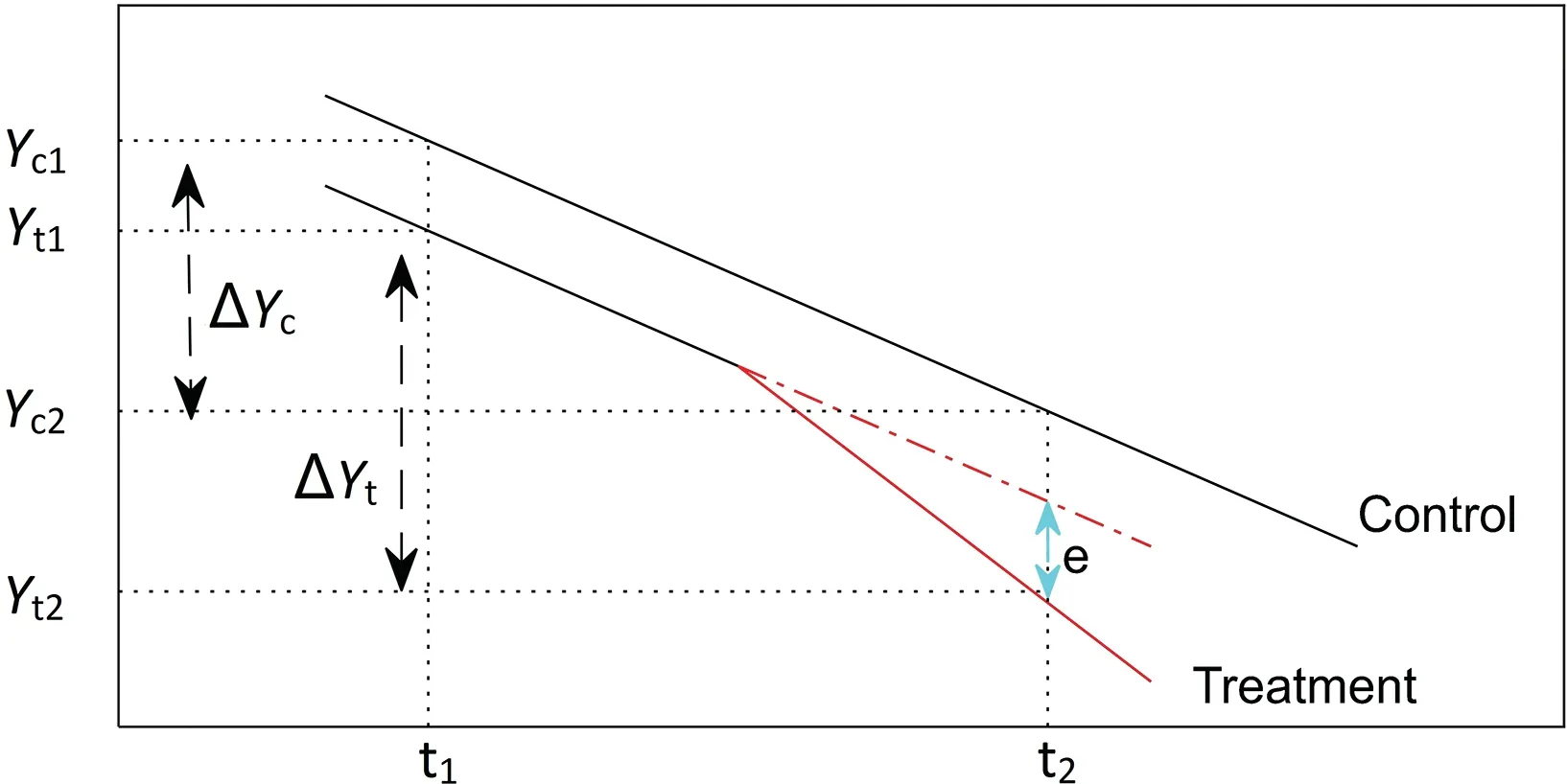
Fig.1.Schematic diagram of DID method.t1 and t2 represent the time before and after the ‘‘policy intervention”.Yc1,Yc2 and Yt1,Yt2 represent respectively the observation results of the control and treatment group samples before and after the‘‘policy intervention”.
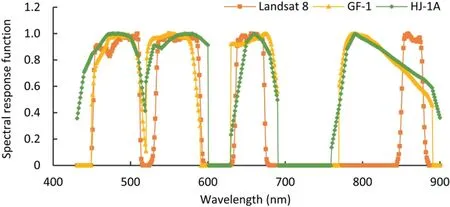
Fig.2.Spectral response functions of sensors in blue,green,red,and near-infrared bands.
The effect (e) of the disease is obtained as the difference between ΔYtand ΔYcin the treatment and control groups before and after infection by the disease.

For example,NDVI decreased after heading of winter wheat[33],and also decreased when stripe rust occurred.The effect of stripe rust can be observed by comparing the NDVI curves of healthy and diseased samples (Fig.3).The respective NDVI curves of the treatment and the control groups reflect the growth status of winter wheat with or without stripe rust infection at the same growth stage.Thus,the independent effect of stripe rust on the canopy spectrum of winter wheat can be quantified by NDVI:
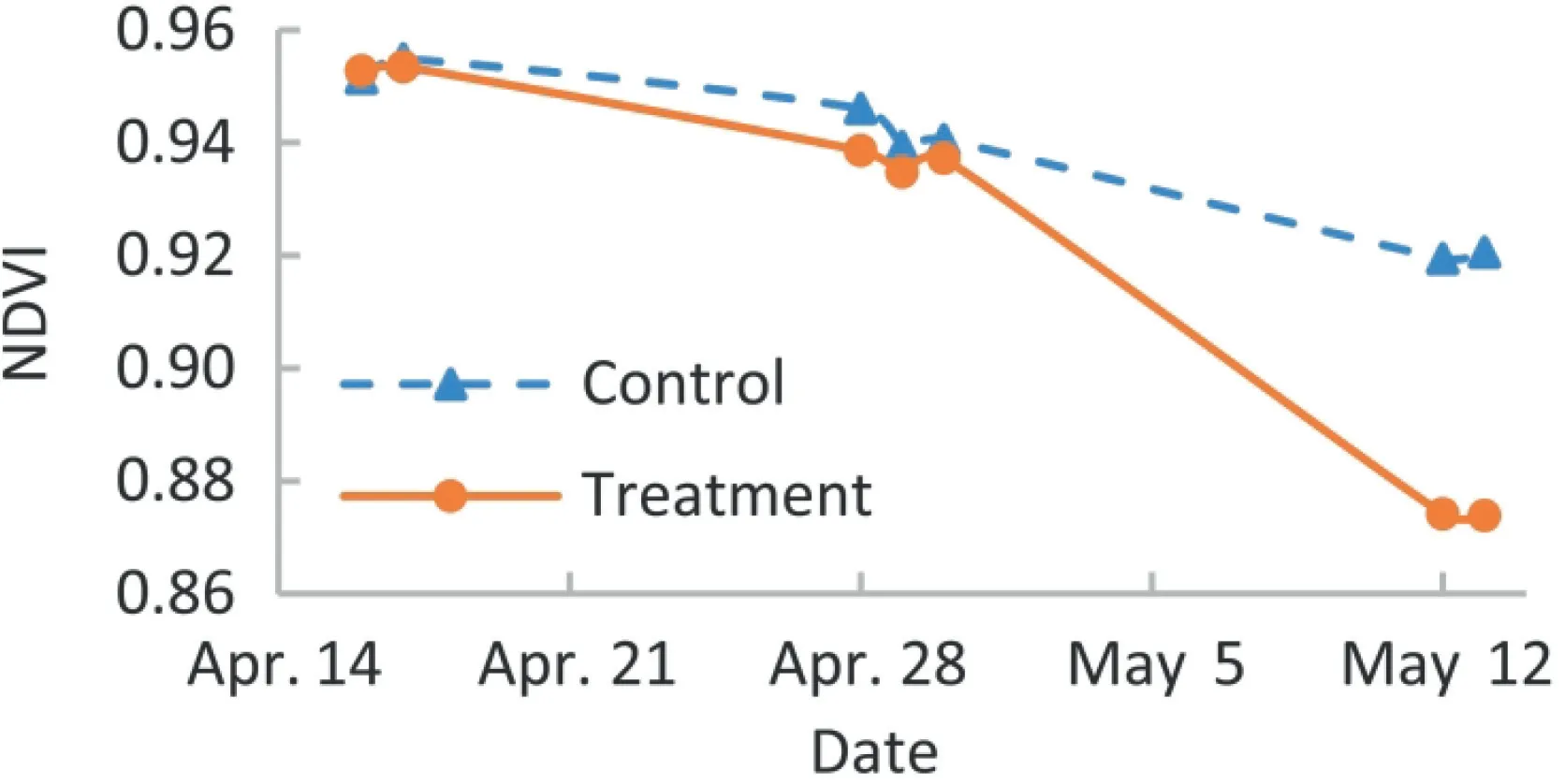
Fig.3.Visual discrimination result of parallel trend test.

Where NDVIc1and NDVIc2are the NDVI values of the control group samples at t1and t2,and NDVIt1and NDVIt2are the NDVI values of the treatment group samples at t1and t2,respectively.NDVI-DID(α3) is the ‘‘net effect” of DID,and is used to quantify the damage to winter wheat caused by various stripe rust severities.The occurrence of stripe rust is treated as a negative policy.The NDVI-DIDis negative after the disease occurs,indicating the adverse influence of stripe rust on winter wheat.The greater the absolute value of NDVI-DID,the more severe the damage.
2.5.Method of simulating multispectral data based on spectral response function
To assess the feasibility of applying the DID algorithm to multispectral satellite data for monitoring wheat stripe rust,we simulated Landsat8,GF-1 and HJ-1A satellite wide-band reflectance from visible light to near-infrared wavelengths.This reflectance was calculated based on the sensor spectral response function(Fig.2) and the wheat canopy hyperspectral data measured in the field natural disease area and the controlled experiment.The wide-band NDVI of different sensors was calculated based on simulated wide-band reflectance and processed by the DID algorithm,with the purpose of comparing the correlations of SL with the wide-band NDVI before and after processing and to assess the applicability of the DID algorithm to several sensors for monitoring stripe rust.
According to the spectral response function of Landsat 8,GF-1 and HJ-1A satellite sensors,the ground-measured hyperspectral data can be simulated as wide-band satellite data.The conversion function is shown in equation (8):

where RSis the simulated satellite wide-band reflectivity,λminand λmaxare the starting and ending wavelengths of the sensor spectral detection,Sλis the spectral response function value of the sensor at λ,and Rλis the reflectance of the wheat canopy spectrum at wavelength λ.
2.6.Statistical analysis
Analysis of variance (ANOVA) and correlation were calculated with SPSS 12.5(SPSS,Chicago,IL,USA).Two-way ANOVA for a single dependent variable was used to test the significance of the differences in slope and intercept between the two models before and after the DID algorithm [34,35].
3.Results
3.1.Parallel trend test of DID
The parallel trend test verifies that the control and treatment groups have the same developmental trend before the disease occurs.It is a prerequisite for the DID algorithm to quantify the effects of the disease on the reflectance spectrum [36].To verify the validity of the parallel trend test,we compared the trends of NDVI curves in the control and the treatment groups from April 16 to April 28 before disease onset (Fig.3).The NDVI curves of the control group (blue dashed line) and the treatment group (orange solid line) showed similar trends.By visual inspection,the parallel trend test was valid for winter wheat in both control and treatment groups.
The trend consistency of the visual inspection results in the control and treatment groups before the policy intervention cannot guarantee the absence of other policies that may affect the trend change during the policy intervention.Changes in the treatment group may be caused by policies other than stripe rust infection in the same period.Placebo tests are performed by fictitious treatment groups or fictitious policy times.The original estimation results may be biased if the regression results of the difference estimators under different fictitious approaches remain significant.Otherwise,the parallel trend test is valid and the change in the treatment group is caused by the policy.
For the fictitious treatment group,we selected healthy samples with SL of 0 as the treatment group.Thus,when the healthy samples received the same treatment as the infected samples via the DID method,the NDVI-DIDof the healthy samples did not correlate with SL.After the real infected samples were treated with DID,NDVI-DIDwas correlated with SL(P<0.001).Thus,the placebo test was effective (Fig.4).
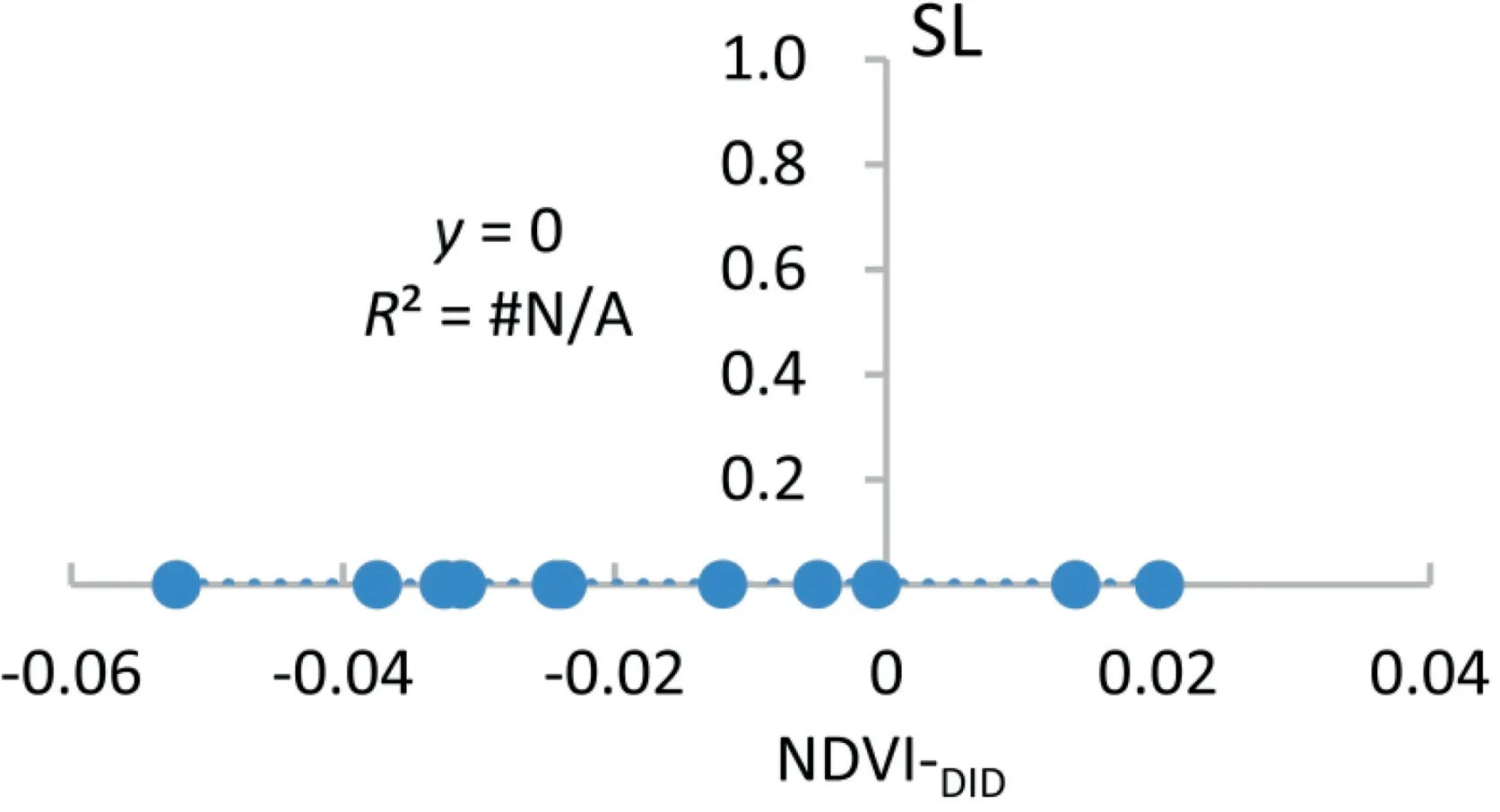
Fig.4.Placebo test in fictional treatment group.
3.2.Correlation between NDVI and SL before and after DID processing
DID processing was performed on the samples of the controlled experiment and the field survey experiment.Based on the Pearson correlation coefficient and the t-test for regression coefficient significance,the correlation between NDVI before and after DID treatment and the measured SL of winter wheat canopy was calculated.The results are shown in Fig.5.
Compared with the original NDVI before processing,the R2value of NDVI-DIDon SL processed by the DID algorithm under the controlled experiment conditions increased by only 1%,and the root mean square error (RMSE) was correspondingly reduced by 0.7% (Fig.5a,b).This is because the controlled experiment better controlled the influence of external factors such as wheat variety,planting time,and management measures.The canopy reflectance spectrum of different quadrats was affected mainly by stripe rust stress rather than by non-physiological stress factors such as growth stage.Thus,for the controlled experiments with relatively consistent external conditions such as growth stage,the accuracy of remote sensing monitoring of stripe rust was not markedly improved after DID processing.
In natural disease areas in large fields,the R2of the regression of NDVI-DIDon SL after the DID processing was 0.4279,and the RMSE was 0.08747(Fig.5c,d),which was 5.3%higher than the R2value of the original NDVI on SL,and the RMSE was reduced by 0.7%.The precision improvement was more marked than in the controlled experiment.The reason is that the canopy reflectance spectra obtained under field conditions came from wheat regions planted separately by different farmers.There were differences in wheat variety,planting time,growth stage,field management,and growth status among plots.Moreover,the canopy reflectance spectrum of different quadrats is not only affected by stripe rust infection,but also perturbed by non-physiological stress factors such as crop growth stage.The net effect (NDVI-DID) evaluated by the DID algorithm includes mainly the effects of disease on winter wheat canopy spectrum,which reflects the degree of infection by P.striiformis on winter wheat.For this reason,the R2of the regression of NDVI-DIDon SL was stronger under field conditions than under controlled experimental conditions.
There were small differences in R2and RMSE between the two experimental results obtained from the controlled experiment and field natural disease condition before and after application of the DID algorithm.In the difference test of slope in the controlled experiment and natural disease area,the regression coefficient of the interaction term was not different(P=0.903 and 0.694)(Tables S1 and S2),but the intercepts were different(P<0.001).This shows that processing with the DID algorithm influenced the regression of NDVI on SL.
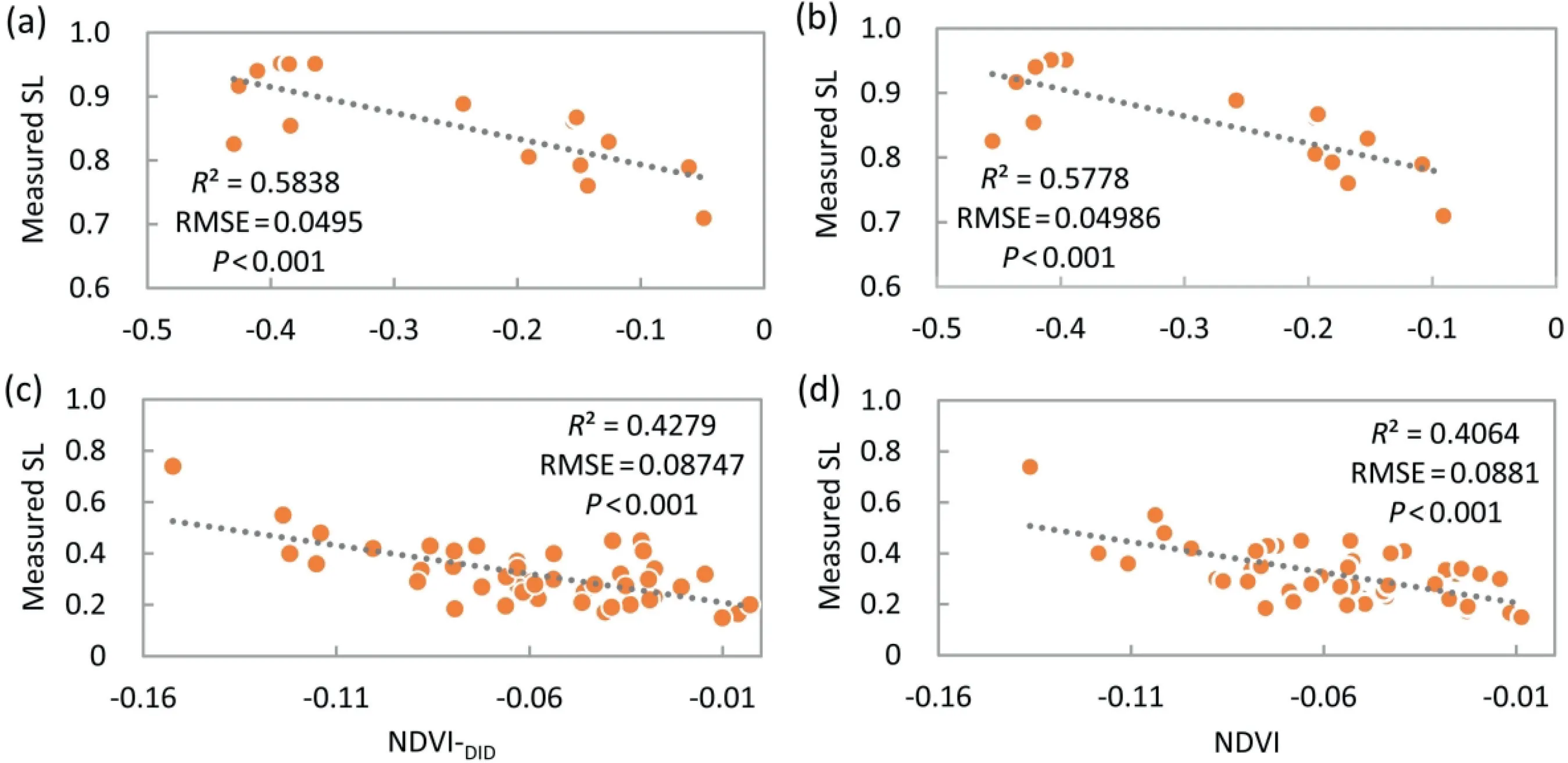
Fig.5.The relationship between NDVI and SL before and after DID treatment under several experimental conditions.(a)and(b)are controlled experiments(n=16).(c)and(d) are the results of the natural disease field (n=45).
As shown in Fig.5,Tables S1 and S2,the greater the influence of non-physiological stress factors on the canopy reflectance spectrum,the more marked was the increase in precision after processing with the DID algorithm.The two-way ANOVA showed that there was a significant difference between the NDVI model and the NDVI-DIDmodel based on the DID algorithm.This finding indicates that the NDVI-DIDestimated by the DID algorithm more accurately reflected the independent effects of stripe rust on winter wheat.
3.3.Applicability of the DID algorithm to diverse disease severities
To evaluate the applicability of the DID algorithm for remote sensing monitoring of wheat stripe rust under different severities,the damaged wheat leaves (infected samples) were grouped into three classes: light (0
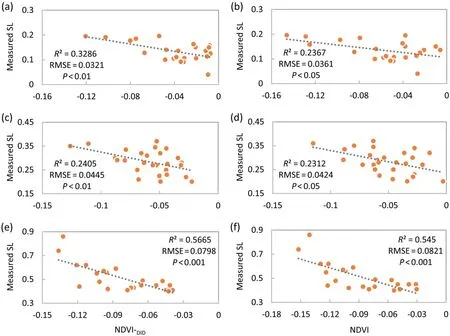
Fig.6.The relationship between NDVI and SL before and after DID treatment in different severities.(a),(c),and (e) show the regressions of SL on NDVI-DID and SL in the natural disease area with light (n=23),moderate (n=27),and severe (n=23) disease,respectively;(b),(d),and (f) show the regressions of SL on NDVI under the corresponding disease severity.
When wheat was under a light disease condition,there was a significant difference in R2of NDVI and SL before and after DID algorithm processing.The R2of NDVI-DIDon SL increased by 38.8% compared with the NDVI,and the RMSE decreased by 11.1%.The correlation between NDVI-DIDand SL was significant(P <0.01).
3.4.Applicability analysis of DID algorithm in diverse VIS
We use NDVI to quantify the response of winter wheat canopy reflectance spectrum to stripe rust.To evaluate the applicability of the DID algorithm to diverse types of VIS,we selected the green normalized difference vegetation index (GNDVI),which reflects sensitivity to moisture and nitrogen concentration in vegetation leaves,the plant senescence reflectance index(PSRI)used to monitor the degree of vegetation senescence,the normalized pigment chlorophyll ratio index(NPCI),which reflects the change of chlorophyll concentration under disease stress,the nitrogen reflectance index (NRI),which directly reflects nitrogen content,the rededge normalized difference vegetation index(RENDVI),which indicates vegetation stress,and the structural independent pigment index(SIPI),which is sensitive to the physiological changes of vegetation (Table 1).

Table 1 Definitions of vegetation index types.
After the various types of VI were processed with the DID algorithm,their correlations with SL were compared with the correlations before processing.The R2of the regression of VIS-DIDon SL for the six types of VI processed by the DID algorithm was increased by at least 6%,with an average improvement of 21.9% (Fig.S1).In particular,NPCI showed significant differences before and after processing (R2=0.45,NPCI-DID;R2=0.099,NPCI).VIS-DIDbetter quantified the effects of stripe rust on the canopy spectrum of winter wheat than VISunder the conditions of satisfying the parallel trend test.
3.5.Applicability of DID algorithm to different sensors
It can be seen in Fig.S2 that there is a difference in R2of NDVI-DIDand SL calculated from simulated wide-band data,but the difference is subtle.The correlation between NDVI-DIDand SL was significant at P <0.001.The correlations between NDVI-DIDand SL calculated based on Landsat 8,GF-1 and HJ-1A sensors were increased in comparison with NDVI before DID processing.The precision of NDVI-DIDcalculated based on Landsat 8 sensors showed the clearest increase.The R2value of NDVI-DIDon SL increased by 14% compared with the simulated wide-band NDVI.After the simulated GF-1 and HJ-1A satellite sensor data were processed by the DID algorithm,the R2values of NDVI-DIDon SL increased by 12.7% and 12.3%,respectively.These results showed that the DID algorithm displayed promise for monitoring wheat stripe rust with remote sensing data from various sensors.
4.Discussion
4.1.Performance of DID algorithm at three severity levels
When the wheat infection was at the severe level(SL>40%),the correlation between NDVI-DIDand SL was highest,but the correlation between NDVI and SL was not significantly increased after DID algorithm processing.The reason may be that under severe infection,P.striiformis continues to infect plant tissues,and the physiological and biochemical parameters and population biomass of wheat have changed [43].Disease stress has become the main factor affecting canopy reflectance spectrum.For this reason,the DID algorithm,which removes the influence of non-physiological stress factors,could not improve the precision of remote sensing monitoring of wheat under the severe disease condition.
When wheat infection was light,there was a significant difference in R2of NDVI on SL before and after DID algorithm processing.The reason is that the reflection spectrum signal,which can effectively reflect the changes of canopy geometry and vegetation biochemical components,has sensitive spectral characteristics to crop population biomass [44].But in the early stage of disease occurrence,disease spots are scattered.Because symptoms are not obvious enough,it is hard to detect the disease status of stripe rust with reflectance spectrum[45,46].In this circumstance,wheat growth stage,growth condition,variety,and other factors have a greater influence on reflectance spectrum data than disease severity.This difference also indicates the feasibility of early detection of diseases using the DID algorithm.
4.2.Performance of VIS processed by DID in stripe rust monitoring
The correlation between VIs-DIDand SL processed by the DID algorithm was increased relative to that before processing,whether VISwith a negative response (decreasing with increases in disease severity level)or with a positive response(VISincreasing with disease severity level) to stripe rust (Fig.S1).In particular,NPCI showed significant differences before and after processing.We speculate that the reason is that NPCI changes with the ratio of total photosynthetic pigment to chlorophyll,which reflects the phenology and physiological state of plants [47].When the incidence of stripe rust is severe,the rapid senescence of crops leads to the loss of chlorophyll,and the carotenoids in senescent leaves are more persistent than chlorophyll [48].
4.3.Advantages and limitations of the DID algorithm
The main advantage of the DID algorithm is that it can effectively isolate the independent effects of stripe rust from the mixed signals in the inherent downward trend of the VI curve during wheat maturation.However,when there are multiple diseases and insect pests or agrometeorological disasters at the same time,the VIS-DIDobtained based on this algorithm reflects the mixed influence of these factors,rather than the independent effects of stripe rust on the canopy spectrum.The DID model based on the field data is reliable in terms of data verification and accuracy evaluation.However,owing to the shortage of large-scale field statistical data that could clearly indicate the extent of crop damage,the validation of research results remains a challenge when remote sensing image data are combined for crop pest and disease monitoring.
5.Conclusions
The correlations between VIS-DIDprocessed by the DID algorithm and SL were increased to varying degrees in comparison with the VISbefore processing.The precision increase was large in the field areas where there were great differences in nonphysiological stress factors such as crop growth stage,growth,planting,and management.The monitoring precision of stripe rust under light disease severity was markedly improved after the DID algorithm processing,providing a reference for early detection of diseases.In the comparison of the adaptability of different types of VISto DID algorithm,the precision increase by pigment NPCI was greatest.The precision increase of NDVI-DIDjustifies the potential of applying the DID algorithm to multispectral satellite data for crop disease monitoring.Under the condition that the control group and the treatment group satisfy the parallel trend test,it effectively eliminated the influence of factors such as growth stage,so as to quantify the response of the canopy reflectance spectrum to stripe rust.These results provide a new means of quantifying crop response to disease.
CRediT authorship contribution statement
Xia Jing:Conceptualization,Writing-review&editing,Project administration,Funding acquisition.Kaiqi Du:Methodology,Investigation,Data curation,Formal analysis,Writing -original draft,Writing-review&editing.Weina Duan:Investigation,Writing -review &editing.Qin Zou:Investigation,Writing -review &editing.Tingting Zhao:Investigation.Bingyu Li:Investigation.Qixing Ye:Investigation.Lieshen Yan:Investigation.
Declaration of competing interest
The authors declare that they have no known competing financial interests or personal relationships that could have appeared to influence the work reported in this paper.
Acknowledgments
This study was supported by the National Natural Science Foundation of China (42171394,41601467).
Appendix A.Supplementary data
Supplementary data for this article can be found online at https://doi.org/10.1016/j.cj.2022.07.009.
- The Crop Journal的其它文章
- Assessing canopy nitrogen and carbon content in maize by canopy spectral reflectance and uninformative variable elimination
- Automatic segmentation of stem and leaf components and individual maize plants in field terrestrial LiDAR data using convolutional neural networks
- Leaf pigment retrieval using the PROSAIL model:Influence of uncertainty in prior canopy-structure information
- The continuous wavelet projections algorithm: A practical spectral-feature-mining approach for crop detection
- Field estimation of maize plant height at jointing stage using an RGB-D camera
- Estimation of spectral responses and chlorophyll based on growth stage effects explored by machine learning methods

